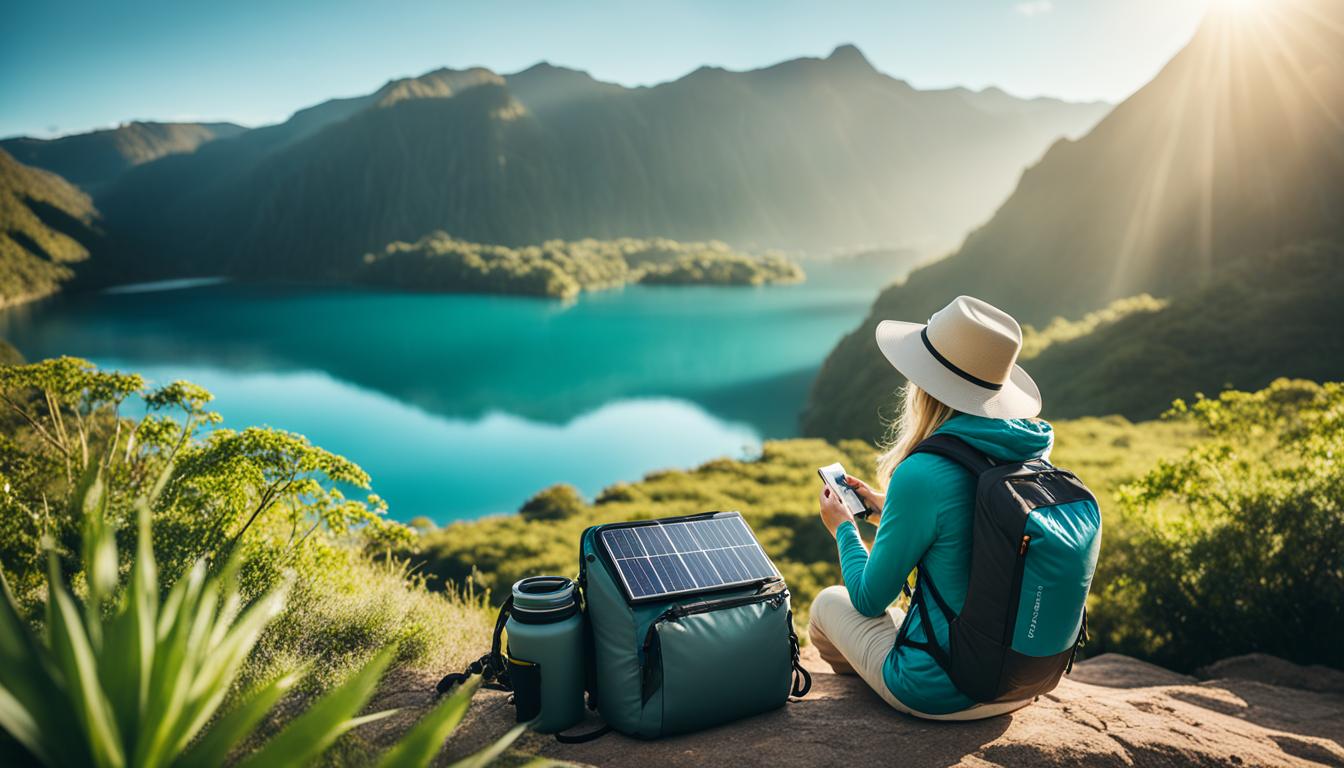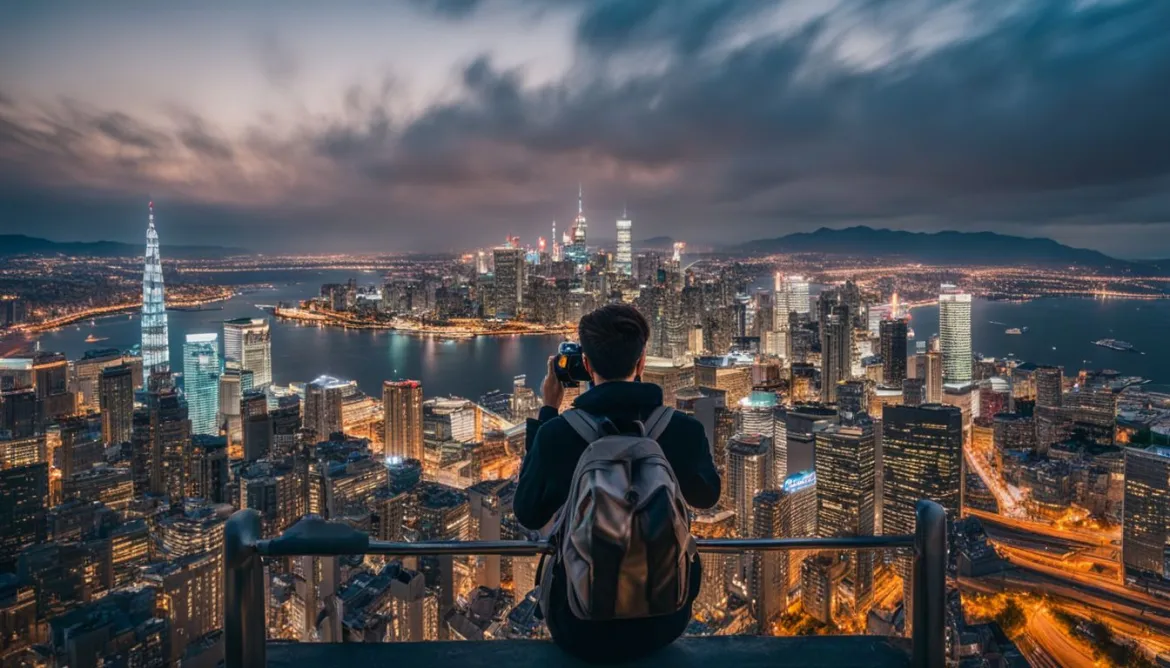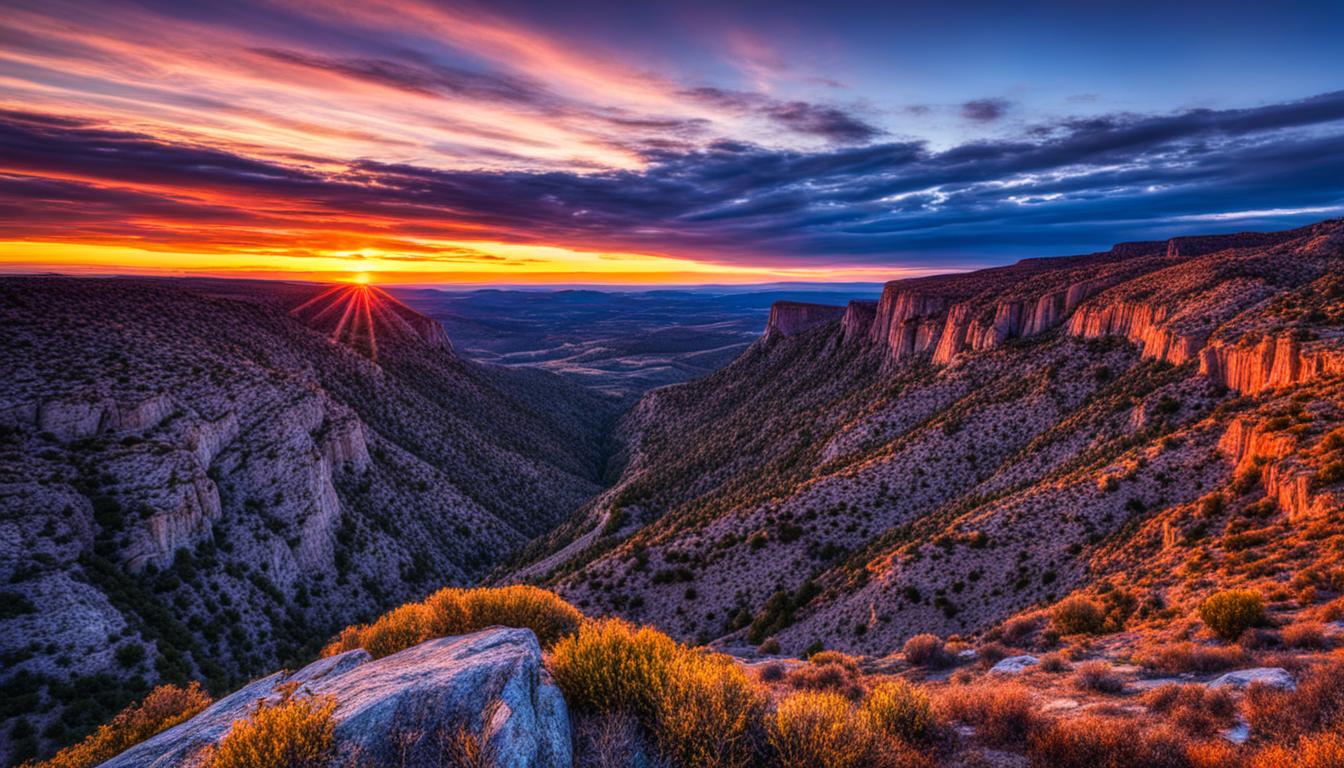Welcome to our guide on eco-friendly travel photography! In this article, we will explore the importance of reducing our carbon footprint in photography and adopting ethical photography practices. As travel photographers, we have the power to capture the beauty of the world, but it is equally important to consider the environmental impact of our craft. Let’s dive in and discover how we can minimize our impact and create a sustainable future for travel photography.
Key Takeaways:
- Adopt eco-friendly practices to minimize your impact on the environment.
- Sustainable travel photography tips include respecting natural environments and minimizing disturbance of wildlife.
- Consider the environmental impact of your modes of transportation and explore alternatives to reduce carbon emissions.
- Both digital and film photography have environmental considerations, but sustainable choices can be made in both realms.
- Choose sustainable travel destinations that prioritize conservation and responsible tourism practices.
Sustainable Travel Photography Tips
When it comes to travel photography, minimizing our environmental impact is key. By adopting sustainable practices, we can ensure that our passion for capturing the world’s beauty doesn’t come at the expense of the planet. Here are some tips to guide you towards responsible and eco-friendly travel photography.
1. Ask for Permission
Respect the people and communities you encounter on your travels by seeking their permission before taking their photographs. This not only shows consideration for their privacy and cultural sensitivities, but it also promotes responsible and ethical travel photography.
2. Respect Natural Environments
When photographing in natural settings, always adhere to the principles of Leave No Trace. Minimize your impact by staying on designated trails, avoiding trampling on delicate flora, and refraining from disturbing wildlife. Remember, we are guests in their habitats.
3. Follow Rules at Historical Sites
Preserve the historical and cultural significance of the places you visit by respecting the rules and regulations in these locations. Avoid touching or climbing on structures, and refrain from using flash photography when it is prohibited to protect delicate artifacts.
4. Minimize Wildlife Disturbance
When photographing wildlife, prioritize their well-being over capturing the perfect shot. Keep a safe distance, use telephoto lenses to avoid intruding, and never bait or force animals into unnatural behavior. Let’s be responsible stewards of the natural world.
5. Choose Eco-Friendly Camera Gear
Opt for eco-conscious camera equipment that minimizes its environmental impact. Look for brands that prioritize sustainability, use recycled materials, or have green certifications. Investing in gear that aligns with your values can make a significant difference.
6. Practice Responsible Photo Editing
Embrace green photography techniques when editing your photos. Avoid excessive editing and manipulation that can lead to unrealistic representations of nature. Instead, aim for authenticity and preserve the natural beauty you captured in your images.
“Sustainable travel photography is about capturing the beauty of the world while leaving a minimal environmental footprint.” – Us
By implementing these sustainable travel photography tips, we can make a positive impact and contribute to the preservation of our planet. Let’s strive to be responsible photographers and inspire others to join us in our commitment to green and ethical practices.
The Impact of Driving and Flying in Travel Photography
When it comes to travel photography, the transportation involved in reaching our destinations can have a significant impact on the environment. Whether we are driving to local spots or flying to international locations, our modes of transportation contribute to carbon emissions and the overall carbon footprint of our travel.
Driving to photography locations often involves using gasoline, which releases carbon dioxide (CO2) into the atmosphere and contributes to climate change. Similarly, flying requires the burning of fossil fuels, releasing CO2 and other greenhouse gases at high altitudes, magnifying their environmental impact.
As photographers, it is essential for us to consider the carbon emissions associated with our travel and explore alternatives to minimize our environmental footprint. By making conscious choices in transportation, we can have a tangible impact in reducing carbon emissions in travel photography.
To illustrate the environmental impact of driving and flying in travel photography, let’s take a closer look at the carbon footprint associated with each mode of transportation:
| Transportation Mode | Estimated CO2 Emissions per Kilometer |
|---|---|
| Driving (Gasoline Vehicle) | 2.3 kilograms of CO2 per kilometer |
| Domestic Flight | 0.19 kilograms of CO2 per kilometer |
| International Flight | 0.17 kilograms of CO2 per kilometer |
These estimates emphasize the importance of considering alternative modes of transportation. For shorter distances, opting for public transportation or electric vehicles can significantly reduce carbon emissions. Meanwhile, for longer distances, choosing more fuel-efficient airlines and supporting sustainable aviation initiatives can help minimize the environmental impact of flying.
Moreover, we can also explore the possibility of offsetting our carbon emissions through verified carbon offset projects. These projects invest in activities that reduce or remove greenhouse gases from the atmosphere, such as reforestation or renewable energy initiatives. By supporting these projects, we can neutralize the carbon emissions associated with our travel photography.
Reducing our carbon footprint in travel photography requires a conscious effort to choose transportation methods that align with our commitment to environmental sustainability. By making informed decisions and embracing alternatives, we can capture incredible photographs while minimizing the negative impact on our planet.
Key Takeaways
- Driving and flying contribute significantly to carbon emissions in travel photography, impacting the environment.
- Gasoline vehicles release CO2 into the atmosphere, while flying burns fossil fuels, magnifying their environmental impact.
- Alternative transportation methods, such as public transportation or electric vehicles, can help reduce carbon emissions for shorter distances.
- Supporting sustainable aviation initiatives and choosing fuel-efficient airlines can minimize the environmental impact of flying for longer distances.
- Offsetting carbon emissions through verified carbon offset projects can neutralize the environmental impact of travel photography.
A Closer Look at Digital Photography
When it comes to minimizing the environmental impact of photography, many photographers turn to digital cameras as a more eco-friendly alternative to film. While digital photography does eliminate the need for film and chemicals, it still has a significant environmental footprint.
One aspect that contributes to the environmental impact of digital photography is the production process of cameras and equipment. The manufacturing of digital cameras involves the extraction and refining of rare metals, which can have harmful effects on ecosystems. Additionally, the energy-intensive manufacturing process contributes to carbon emissions.
“The manufacturing of digital cameras involves the extraction and refining of rare metals, which can have harmful effects on ecosystems.”
Another concern is the disposal of digital waste. As technology advances, photographers often upgrade their equipment, leading to the accumulation of old and obsolete devices. Improper disposal of digital cameras and electronic waste contributes to the growing problem of electronic waste pollution.
The Solution: Sustainable Digital Photography
To minimize the environmental impact of digital photography, photographers can take proactive steps towards sustainability. Here are some ideas:
- Consider purchasing second-hand or refurbished equipment. This reduces the demand for new manufacturing and helps extend the lifespan of existing devices.
- Dispose of old electronics responsibly. Look for e-waste recycling programs in your area to ensure proper recycling and minimize the release of hazardous materials into the environment.
- Invest in high-quality, durable camera gear. By choosing durable equipment, you can minimize the need for frequent replacements and reduce waste.
- Practice responsible photo editing techniques. Optimize your workflow to minimize energy consumption and reduce file sizes when possible.
By adopting sustainable practices in digital photography, we can reduce the environmental impact of our craft and contribute to a more sustainable future.
| Environmental Impact of Digital Photography | Actions to Minimize Impact |
|---|---|
| Extraction and refining of rare metals | Choose second-hand or refurbished equipment |
| Carbon emissions from manufacturing process | Dispose of old electronics responsibly |
| Disposal of digital waste | Invest in high-quality, durable camera gear |
| Practice responsible photo editing techniques |

The Environmental Concerns of Film Photography
While film photography has a nostalgic charm, it also raises environmental considerations. The production and development of film involve the use of chemicals and materials that can have a detrimental impact on the environment, polluting soil and water sources. It is important to address these concerns and explore sustainable alternatives to minimize the ecological impact of film photography.
The Ecological Impact of Film Photography
Film photography relies on various chemicals and materials throughout the process, including film emulsions, developing solutions, and fixers. These substances can contain harmful compounds such as silver, heavy metals, and volatile organic compounds (VOCs). Improper disposal of these chemicals can lead to contamination of soil, waterways, and ecosystems, affecting biodiversity and human health.
Furthermore, the manufacturing of film involves resource extraction, energy consumption, and greenhouse gas emissions. The production of film rolls, packaging materials, and other related accessories contributes to the industry’s carbon footprint. Considering these factors, it is essential to seek more sustainable practices within film photography.
“Film photography relies on chemicals and materials that can contribute to pollution and adverse environmental impacts.”
Sustainable Approaches in Film Photography
Despite these concerns, there are sustainable practices and alternatives that can help reduce the ecological footprint of film photography. By adopting these approaches, photographers can enjoy the art of film while minimizing their impact on the environment.
- Opt for eco-friendly film options: Some manufacturers produce films that are designed with reduced environmental impact. These films often utilize more sustainable materials and chemicals, making them a greener choice for photographers.
- Choose eco-friendly film development labs: Many traditional film labs incorporate sustainable practices into their operations. These labs prioritize proper waste management, recycling, and the use of environmentally friendly development processes.
- Limit the number of prints: By being more selective and intentional with printing, photographers can reduce waste and conserve resources. Choosing to print only the most meaningful and impactful photos helps minimize the overall ecological impact of film photography.
- Practice responsible disposal: It is crucial to dispose of film chemicals properly to avoid environmental contamination. Local authorities or dedicated recycling centers often have specific guidelines for the disposal of hazardous materials like film chemicals.
In addition to these practices, photographers can also explore alternative methods of developing film, such as using eco-friendly developing kits at home. These kits often use minimal chemicals and are designed for efficient and environmentally conscious development processes.
Choosing Sustainable Travel Destinations
When it comes to travel photography, our choices can have a significant impact on the environment. Many popular tourist destinations are already facing the negative consequences of over-tourism and excessive pollution. As photographers, we have the power to make a difference by consciously opting for eco-friendly travel destinations that prioritize conservation, minimize waste, and promote responsible tourism practices.
By supporting eco-friendly accommodations and local communities, we can contribute to the preservation of natural environments and cultural heritage. These sustainable travel destinations offer unique opportunities for capturing the beauty of the world while minimizing our ecological footprint. Let’s explore how making responsible travel choices can create a positive impact on the environment and our photography.
Preserving Natural Environments
Choosing eco-friendly travel destinations allows us to immerse ourselves in untouched landscapes and vulnerable ecosystems. These destinations prioritize the preservation of natural habitats, promoting sustainable practices that protect the flora and fauna we photograph. By visiting these areas, we can showcase their beauty and raise awareness about the importance of conservation.
Minimizing Waste and Pollution
Responsible travel destinations actively work towards minimizing waste and pollution. They implement recycling programs, encourage the use of reusable products, and reduce their reliance on single-use plastics. By supporting these efforts, we can contribute to a cleaner and healthier environment, ensuring that future generations can also enjoy the beauty of these places.
Promoting Local Communities
Sustainable travel destinations prioritize the well-being of local communities, ensuring that the benefits of tourism reach the people who call these places home. By staying in eco-friendly accommodations and supporting local businesses, we can contribute to the thriving of these communities and their economic sustainability. Moreover, engaging with locals allows us to have authentic cultural experiences and create meaningful connections.
“Traveling in harmonious synergy with nature and communities allows us to capture the essence of a place while preserving its integrity for future generations.” – Responsible Travel Photographer
By choosing sustainable travel destinations, we can align our passion for travel photography with our commitment to environmental stewardship. These destinations provide us with enriching experiences, stunning landscapes, and unique cultural encounters, all while making a positive impact on the world around us.
| Benefits of Choosing Sustainable Travel Destinations | Examples of Sustainable Travel Destinations |
|---|---|
|
|
Practicing Responsible Photography Education and Advocacy
Educating other photographers and advocating for sustainable practices in photography can have a significant impact. At Our Photography Community, we believe in promoting responsible photography education and raising awareness about the environmental consequences of travel photography. By sharing knowledge about sustainable gear, techniques, and travel choices, we can inspire a collective effort towards reducing the environmental footprint of the photography industry.
Through our platform, we aim to provide resources and guidance on how to minimize the environmental impact of photography education. By incorporating eco-conscious photography advocacy into our teaching, we can equip aspiring photographers with the tools and knowledge to be more environmentally conscious in their practice.
“The best way to make a difference is to lead by example.”
Our community encourages photographers to actively promote sustainable practices in photography. By sharing our experiences and showcasing the beauty of eco-friendly photography, we can inspire others to adopt these practices. Through collaboration and collective action, we can make a real impact on reducing the environmental footprint of the photography industry.
One way we advocate for sustainable practices is by highlighting photographers and brands that prioritize environmentally friendly approaches. We feature interviews, articles, and case studies that showcase the innovative methods these individuals and organizations use to minimize their impact on the environment. By celebrating their successes, we hope to inspire others to follow suit.
Join the Movement
We invite all photographers to join us in promoting sustainable practices in photography. Together, we can create a community that values environmental stewardship and actively works towards minimizing the ecological impact of our craft.
- Share your knowledge: Contribute to our platform and share your tips, tricks, and experiences with sustainable photography practices.
- Spread the word: Use your online platforms and social media presence to raise awareness about the environmental impact of photography and the importance of eco-conscious advocacy.
- Support eco-friendly brands: Choose to work with brands that prioritize sustainability, whether it be camera manufacturers, accessory producers, or printing services.
Together, we can promote a more sustainable future for the photography industry and make a positive impact on the environment.

| Impact of Photography Education on the Environment | Eco-Conscious Photography Advocacy Strategies |
|---|---|
| 1. High production of teaching materials and resources contribute to deforestation and waste. | 1. Emphasize the use of digital resources and online platforms to minimize paper waste. |
| 2. Travel requirements for photography workshops and classes increase carbon emissions. | 2. Encourage local workshops and utilize virtual teaching methods whenever possible. |
| 3. Lack of awareness among photography students about sustainable practices. | 3. Integrate sustainability education into photography curriculum and workshops. |
| 4. Waste generated from disposable materials used in hands-on photography exercises. | 4. Promote the use of reusable and eco-friendly alternatives for hands-on activities. |
| 5. Limited focus on responsible travel and ethical photography in educational programs. | 5. Incorporate modules on responsible travel and ethical photography into photography courses. |
Conclusion
In conclusion, eco-friendly travel photography is essential for minimizing the environmental impact of this popular hobby. As photographers, we have the power to make a difference by adopting sustainable practices and responsible travel choices. By doing so, we can reduce our carbon footprint, minimize waste, and preserve the natural wonders we capture through our lenses.
One way to minimize environmental impact in photography is by choosing eco-friendly gear. Opting for equipment that is energy-efficient, made from sustainable materials, or second-hand can significantly reduce the production of electronic waste and carbon emissions. Additionally, practicing responsible photo editing techniques, such as optimizing file sizes and using efficient workflows, can help minimize digital waste.
Furthermore, making conscious travel choices is crucial in eco-friendly photography. Selecting sustainable travel destinations, supporting eco-conscious accommodations, and respecting local communities and natural environments can contribute to the preservation and protection of our planet. By advocating for sustainable photography practices and sharing our knowledge with others, we can inspire a collective effort towards minimizing the environmental impact of the photography industry.
Ultimately, as photographers, it is our responsibility to capture the beauty of the world while also taking care of it. By embracing eco-friendly practices and minimizing our environmental impact, we can ensure that future generations can enjoy the same wonders and experiences that inspire us today. Let us continue to make mindful choices and contribute to a more sustainable future for travel photography.
FAQ
What are some eco-friendly practices for travel photography?
Eco-friendly practices for travel photography include asking for permission before photographing people, respecting natural environments, adhering to rules around historical sites, and minimizing the disturbance of wildlife.
How can I minimize my carbon footprint in travel photography?
You can minimize your carbon footprint in travel photography by considering the environmental impact of your modes of transportation and exploring alternatives, such as using public transportation or choosing destinations that are closer to home.
How can I reduce waste and minimize the environmental impact of digital photography?
To reduce waste and minimize the environmental impact of digital photography, you can choose second-hand or refurbished camera equipment, properly dispose of old electronics, and practice responsible photo editing techniques to optimize your digital images instead of capturing multiple shots.
What are the environmental concerns associated with film photography?
Film photography has environmental concerns such as the production and development of film that involve the use of chemicals and materials that can pollute soil and water. Proper disposal of film chemicals is crucial to prevent contamination.
How can I choose sustainable travel destinations for photography?
To choose sustainable travel destinations for photography, you can look for destinations that prioritize conservation, minimize waste, and promote responsible tourism practices. Supporting eco-friendly accommodations and local communities can also make a positive impact.
How can I promote sustainable practices in photography?
You can promote sustainable practices in photography by educating other photographers about eco-friendly gear, techniques, and travel choices. Advocating for responsible photography education and raising awareness about the environmental consequences of travel photography can also make a significant impact.
How can I minimize my impact on the environment as a travel photographer?
As a travel photographer, you can minimize your impact on the environment by adopting sustainable practices such as using eco-friendly camera gear, choosing alternative modes of transportation, reducing waste, respecting natural and historical sites, and supporting sustainable travel destinations.
How Can Secure Gear on the Go Help Minimize Environmental Impact in Travel Photography?
When traveling for photography, using tips for secure travel photography gear can help minimize environmental impact. By keeping gear safe and secure, photographers can avoid damaging equipment and lessen the need for replacements, reducing waste. This allows photographers to focus on capturing the beauty of the environment without contributing to its degradation.




